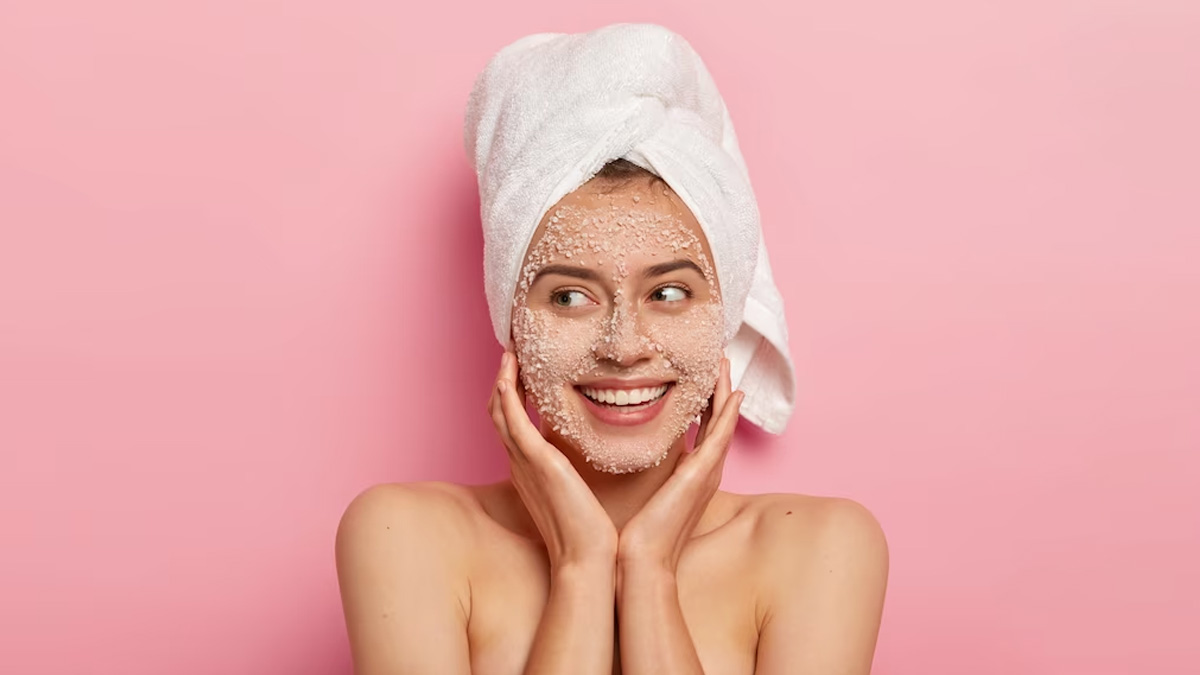
The skincare routine has become widely recognised for its ability to protect, nurture, and improve skin. One of the steps that helps you achieve healthy skin is exfoliation. It helps remove dead skin cells, unclog pores, and promote healthier, glowing skin. When done correctly, exfoliation can leave your complexion looking fresh, radiant, and youthful. However, improper exfoliation can lead to skin irritation, dryness, and even damage.We spoke to our expert Dr Geetika Srivastava, Dermatologist and Founder, Influennz- Hair & Skin Clinic, who listed the steps you should follow to exfoliate your face properly.
Dr Srivastava said, "Our skin turnover time is 30-60 days roughly. This means that even with no skincare routine, our skin will replace itself in 60 days. The process of skin renewal is enhanced with the process of exfoliation."
Expert Tips To Exfoliate Your Face The Right Way

Determine Your Skin Type
It is essential to understand your skin type before starting with exfoliation. Understanding your skin's unique needs will help you choose the right exfoliation method. When it comes to at-home exfoliation, there are primarily two approaches: mechanical and chemical.
Dr Srivastava added, "The skin type will determine the frequency of exfoliation. Sensitive skin types should stay away from exfoliation in general. Oily skin type is the most resilient so they can use exfoliation even thrice a week. Dry skin types should be weary of exfoliation and should practice exfoliation not more than once a week."
According to the American Academy of Dermatology Association, mechanical exfoliation involves the use of tools like brushes, sponges, or scrubs to physically eliminate dead skin cells, while chemical exfoliation relies on the use of compounds like alpha and beta hydroxy acids to delicately dissolve these cells.

Choose the Right Exfoliant
You can start choosing the right exfoliant for your skin once you know about your skin type.
- Scrubs: Physical exfoliants often come in the form of scrubs, which contain tiny granules like sugar, salt, or microbeads. These can be effective for removing dead skin cells, but they can also be abrasive if used too vigorously. Dr Srivastava said, "Therefore, be gentle when applying them, and avoid scrubs with large, irregular particles that may cause microtears in the skin. When it comes to physical scrubs, the smaller the particle size, the better the scrub."
- Chemical Exfoliants: For chemical exfoliation, AHAs (glycolic acid and lactic acid) and BHAs (salicylic acid) are common choices. AHAs are great for dry or sun-damaged skin, as they work on the skin's surface, while BHAs are effective for oily or acne-prone skin, as they penetrate the pores to unclog them.
Patch Test
Before using any new exfoliant, it's essential to perform a patch test. Put a small quantity of the product on a less noticeable part of your skin, like behind your ear or on your inner wrist. Wait 24-48 hours to ensure that your skin doesn't react adversely. If you experience redness, itching, or burning, choose a different product or consult a dermatologist.
Follow a Routine
Incorporate exfoliation into your skincare routine 1-3 times a week, depending on your skin's needs and tolerance. Avoid over-exfoliating, as this can strip your skin of its natural protective barrier and lead to irritation. Be consistent in your schedule to see the best results.

Cleanse Your Face
Before you exfoliate, cleanse your face to remove makeup, dirt, and impurities. Using a gentle cleanser will ensure that your exfoliant can work effectively without any barriers. Dr Srivastava added, "The ideal steps of a skincare routine are cleansing-exfoliation-actives or serums-moisturisation followed by sunscreen if done in the morning. It's best to practice exfoliation at night when there is no sun exposure to hamper the skin."
Apply Exfoliant
For physical exfoliants, gently massage the product onto your face using circular motions. Pay special attention to areas, such as the forehead, nose, and chin. Exercise caution to avoid excessive rubbing, as it may lead to skin irritation.
For chemical exfoliants, apply a thin layer of the product to your clean, dry face. Follow the instructions on the product packaging for guidance on the application time. It's crucial to avoid the eye area and any open wounds or irritated skin.
Also Read: Are You Exfoliating Your Skin More Than What’s Required? Know Signs of Over-Exfoliated Skin
Be Patient
After applying the exfoliant, let it sit for the recommended time, usually a few minutes. The product will work to break down dead skin cells, so there's no need to scrub vigorously.

Rinse Thoroughly
When the waiting period is over, rinse your face with lukewarm water to remove the exfoliant. Make sure there's no residue left on your skin, as this can lead to irritation.
Moisturise
After exfoliation, your skin may be more sensitive, so it's essential to moisturise. Choose a gentle, hydrating moisturiser that suits your skin type. This will help lock in moisture and protect your newly revealed skin.
Sun Protection
One of the most crucial steps after exfoliation is sun protection. Exfoliated skin is more vulnerable to UV damage, so always apply sunscreen with SPF 30 or higher to shield your skin from harmful UV rays. This step is vital for preventing pigmentation issues and maintaining a glowing complexion.
Avoid Harsh Products
While exfoliating, it's a good idea to avoid using other harsh skincare products like retinoids or intense peels on the same day. These can potentially irritate your skin when combined with exfoliants.
Listen to Your Skin
Regularly assess how your skin is responding to the exfoliation process. If you notice excessive dryness, redness, or irritation, reduce the frequency of exfoliation or switch to a milder product. It's important to adapt your routine to your skin's changing needs.
[Disclaimer: The information in this article is provided by a registered healthcare professional and is for informational purposes only. We advise you to consult your expert before trying any skincare ritual, especially if you are dealing with any skin conditions.]







